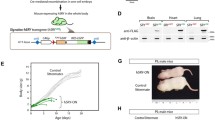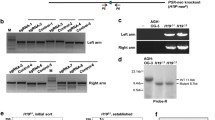Abstract
Puberty onset in mammals is affected by multiple genetic and environmental factors. Among which, the maternal effect could have played a considerable role. In our previous study, we found that the F1 offspring from reciprocal crosses between C3H/HeJ (C3H) and C57BL/6J (B6) mice differed significantly in the timing of puberty in both sexes, though they had identical genomic background. In order to dissect the causative factors to such phenomenon of maternal effect, embryos from reciprocal crosses of C3H/HeJ and C57BL/6J mice were collected and transplanted to the uterus of either strain of mothers, and the puberty onset of pups were compared between different recipient mothers and egg origins. The results showed that the male pups from C3H recipient mothers attained puberty onset earlier than those from B6 recipients significantly. while the female pups did not show such difference. On the other hand, the egg origin made no difference in the puberty onset of either sex, yet it influenced the birth weight of female pups significantly (p<0.05). The manipulation of embryo transplantation delayed the puberty onset of pups dramatically. A mitochondria substitution strain between B6 and C3H (BmC), which had the genome background of B6 and a mitochondrial hyplotype of C3H, had the same phenotype of puberty onset as B6. The integrated results indicated that the uterine environment was the major causative factors to the maternal effect on the differential puberty onset in reciprocal crosses of F1 hybrids between B6 and C3H mice.
Similar content being viewed by others
References
de Roux N, Genin E, Carel JC, Matsuda F, Chaussain JL, Milgrom E. Hypogonadotropic hypogonadism due to loss of function of the KiSS1-derived peptide receptor GPR54. Proc Natl Acad Sci U S A 2003, 100: 10972–6.
Lapatto R, Pallais JC, Zhang D, et al. Kiss1 -/- mice exhibit more variable hypogonadism than Gpr54-/- mice. Endocrinology 2007, 148: 4927–36.
Bédécarrats GY, Kaiser UB. Mutations in the human gonadotropinreleasing hormone receptor: insights into receptor biology and function. Semin Reprod Med 2007, 25: 368–78.
Wehkalampi K, Widén E, Laine T, Palotie A, Dunkel L. Association of the timing of puberty with a chromosome 2 locus. J Clin Endocrinol Metab 2008, 93: 4833–9.
Rothenbuhler A, Fradin D, Heath S, et al. Weight-adjusted genome scan analysis for mapping quantitative trait Loci for menarchal age. J Clin Endocrinol Metab 2006, 91: 3534–7.
Sulem P, Gudbjartsson DF, Rafnar T, et al. Genome-wide association study identifies sequence variants on 6q21 associated with age at menarche. Nat Genet 2009, 41: 734–8.
He C, Kraft P, Chen C, Buring JE, et al. Genome-wide association studies identify loci associated with age at menarche and age at natural menopause. Nat Genet 2009, 41: 724–8.
Ojeda SR, Lomniczi A, Mastronardi C, et al. Minireview: the neuroendocrine regulation of puberty: is the time ripe for a systems biology approach? Endocrinology 2006, 147: 1166–74.
Robinson JJ, Sinclair KD, McEvoy TG. Nutritional effects on foetal growth. Anim Sci 1999, 68: 315–31.
Brooks AN, Hagan DM, Sheng C, McNeilly AS, Sweeney T. Prenatal gonadotrophins in sheep. Anim Reprod Sci 1996, 42: 471–81.
Léonhardt M, Lesage J, Croix D, Dutriez-Casteloot I, Beauvillain JC, Dupouy JP. Effects of perinatal maternal food restriction on pituitary-gonadal axis and plasma leptin level in rat pup at birth and weaning and on timing of puberty. Biol Reprod 2003, 68: 390–400.
Engelbregt MJ, van Weissenbruch MM, Popp-Snijders C, Lips P, Delemarre-van de Waal HA. Body mass index, body composition, and leptin at onset of puberty in male and female rats after intrauterine growth retardation and after early postnatal food restriction. Pediatr Res 2001, 50: 474–8.
Smith JT, Waddell BJ. Increased fetal glucocorticoid exposure delays puberty onset in postnatal life. Endocrinology 2000, 141: 2422–8.
Hilakivi-Clarke L, Clarke R, Onojafe I, Raygada M, Cho E, Lippman M. A maternal diet high in n — 6 polyunsaturated fats alters mammary gland development, puberty onset, and breast cancer risk among female rat offspring. Proc Natl Acad Sci 1997, 94: 9372–7.
Zhu W, Fan Z, Zhang C, et al. A dominant X-linked QTL regulating pubertal timing in mice found by whole genome scanning and modified interval-specific congenic strain analysis. PLoS One 2008, 3: e3021.
Zhou Y, Zhu W, Guo Z, Zhao Y, Song Z, Xiao J. Effects of maternal nuclear genome on the timing of puberty in mice offspring. J Endocrinol 2007, 193: 405–12.
Xiao Z, Xiao J, Jiang Y, et al. A novel method based on ligase detection reaction for low abundant YIDD mutants detection in hepatitis B virus. Hepatol Res 2006, 34: 150–5.
Jiao F, Yan JB, Yang XY, et al. Effect of oocyte mitochondrial DNA haplotype on bovine somatic cell nuclear transfer efficiency. Mol Reprod Dev 2007, 74: 1278–86.
Murphy VE, Smith R, Giles WB, Clifton VL. Endocrine regulation of human fetal growth: the role of the mother, placenta, and fetus. Endo Rev 2006, 27: 141–69.
Demmelmair H, von Rosen J, Koletzko B. Long-term consequences of early nutrition. Early Hum Dev 2006, 82: 567–74.
Kaneda A, Wang CJ, Cheong R, et al. Enhanced sensitivity to IGF-II signaling links loss of imprinting of IGF2 to increased cell proliferation and tumor risk. Proc Natl Acad Sci U S A 2007, 104: 20926–31.
Wittkopp PJ, Haerum BK, Clark AG. Parent-of-origin effects on mRNA expression in Drosophila melanogaster not caused by genomic imprinting. Genetics 2006, 173: 1817–21.
Dong C, Li WD, Geller F, et al. Possible genomic imprinting of three human obesity-related genetic loci. Am J Hum Genet 2005, 76: 427–37.
Kwong WY, Miller DJ, Ursell E, et al. Imprinted gene expression in the rat embryo-fetal axis is altered in response to periconceptional maternal low protein diet. Reproduction 2006, 132: 265–77.
Han L, Szabó PE, Mann JR. Postnatal survival of mice with maternal duplication of distal chromosome 7 induced by a Igf2/H19 imprinting control region lacking insulator function. PLoS Genet 2010, 6: e1000803.
Ahima RS, Dushay J, Flier SN, Prabakaran D, Flier JS. Leptin accelerates the onset of puberty in normal female mice. J Clin Invest 1997, 99: 391–5.
Da Silva P, Aitken RP, Rhind SM, Racey P A, Wallace JM. Influence of placentally mediated fetal growth restriction on the onset of puberty in male and female lambs. Reproduction 2001, 122: 375–83.
Zambrano E, Rodríguez-González GL, Guzmán C, et al. A maternal low protein diet during pregnancy and lactation in the rat impairs male reproductive development. J Physiol 2005, 563: 275–84.
Guzmán C, Cabrera R, Cárdenas M, Larrea F, Nathanielsz PW, Zambrano E. Protein restriction during fetal and neonatal development in the rat alters reproductive function and accelerates reproductive ageing in female progeny. J Physiol 2006, 572: 97–108.
Rojas-Marcos PM, David R, Kohn B. Hormonal effects in infants conceived by assisted reproductive technology. Pediatrics 2005, 116: 190–4.
Schelbach CJ, Kind KL, Lane M, Thompson JG. Mechanisms contributing to the reduced developmental competence of glucosamine-exposed mouse oocytes. Reprod Fertil Dev 2010, 22: 771–9.
Scott KA, Yamazaki Y, Yamamoto M, et al. Glucose parameters are altered in mouse offspring produced by assisted reproductive technologies and somatic cell nuclear transfer. Biol Reprod 2010, 83: 200–7.
Author information
Authors and Affiliations
Corresponding author
Rights and permissions
About this article
Cite this article
Zhou, Y., Guan, Q., Li, K. et al. Dissection of the maternal effects on puberty onset by embryo transplantation in mouse. J Endocrinol Invest 35, 676–680 (2012). https://doi.org/10.3275/8125
Accepted:
Published:
Issue Date:
DOI: https://doi.org/10.3275/8125




